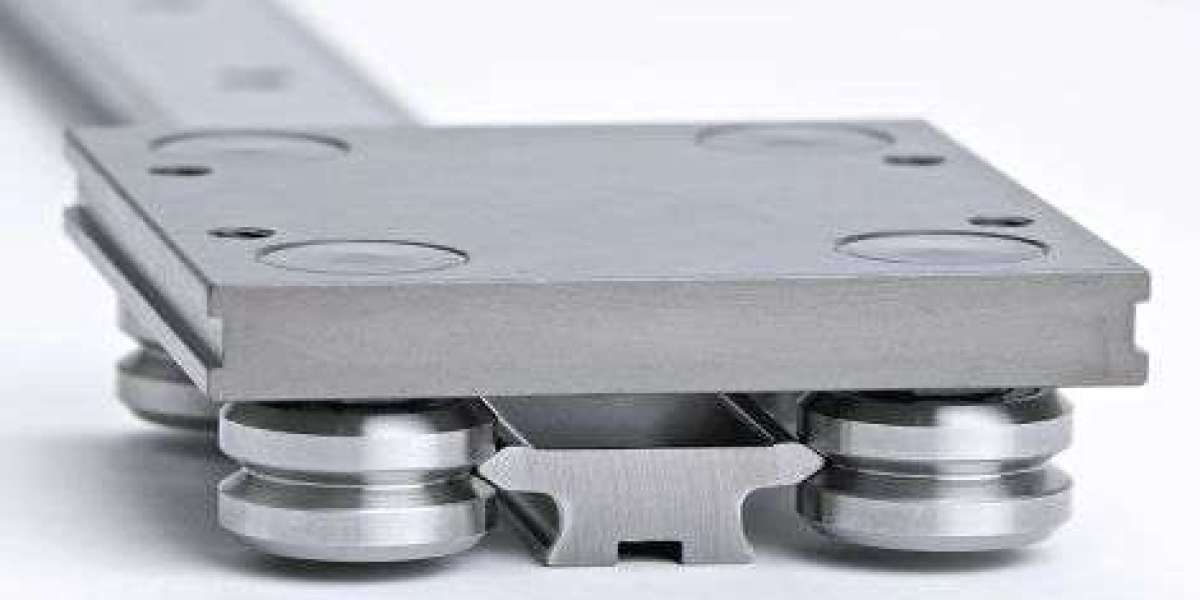This article delves into the world of linear rail bearings, exploring their fundamental principles, types, applications, and the key factors that engineers must consider when selecting the right system. We'll also examine how these components contribute to the efficiency and precision of modern industrial operations and highlight how leading manufacturers are pushing the boundaries of what's possible with linear rail bearing technology.
What Are Linear Rail Bearings?
Linear rail bearings are mechanical components specifically engineered to facilitate smooth, low-friction movement along a straight axis while supporting substantial loads. They consist of two primary elements: a precision-machined rail (also called a guide rail) and a carriage (or slider) that moves along the rail. The carriage houses rolling elements—typically steel balls or rollers—that interact with raceways on the rail to reduce friction and ensure precise motion.
Unlike traditional sliding bearings that rely on direct metal-to-metal contact (which generates high friction and wear), linear rail bearings use rolling elements to convert sliding friction into rolling friction. This fundamental difference results in significantly lower friction coefficients, enabling smoother motion, higher speeds, and greater load-bearing capacity. The rolling elements are contained within the carriage and are often part of a recirculating system, meaning they can continuously move along the rail without the need for external return mechanisms.
Key Components and Working Principles
1. The Rail (Guide Rail)
The rail is the fixed component of the linear rail bearing system and serves as the path along which the carriage moves. It is typically made from high-quality hardened steel or stainless steel to withstand wear, corrosion, and heavy loads. The rail's surface is precision-machined with one or more raceways (grooves) that guide the rolling elements. The geometry and surface finish of the rail are critical, as they directly impact the system's accuracy, smoothness, and load distribution.
- •
Rail Profiles: Linear rail bearings come in various rail profiles, with the most common being the square or profiled rail. These rails feature multiple raceways (often two to four) that allow the rolling elements to distribute the load evenly across the rail, enhancing rigidity and stability.
- •
Materials: High-carbon chromium steel is the most common material for rails due to its excellent hardness and wear resistance. Stainless steel is used in corrosive or cleanroom environments.
- •
Surface Finish: Precision-ground or honed surfaces ensure smooth interaction with the rolling elements, minimizing friction and wear.
2. The Carriage (Slider)
The carriage is the moving component that attaches to the load (e.g., a tool, platform, or workpiece) and houses the rolling elements. It is designed to glide smoothly along the rail while maintaining precise alignment and load distribution. The carriage typically contains one or more sets of rolling elements, which are arranged in a way that allows them to recirculate continuously as the carriage moves.
- •
Rolling Elements: Steel balls are the most common rolling elements, offering a balance of low friction and high load capacity. Cylindrical rollers are used in applications requiring higher load capacity and rigidity.
- •
Preload System: Many linear rail bearings feature a preload system that applies a slight internal tension to eliminate clearance (play) between the carriage and rail. This enhances rigidity and ensures precise positioning, especially in high-precision applications.
- •
Attachment Features: The carriage includes mounting holes or slots for securing the load, ensuring a secure and stable connection.
3. Rolling Elements and Recirculation
The rolling elements are the key to reducing friction and enabling smooth motion. In a recirculating system, the rolling elements move along the rail's raceways and are then redirected back to the front of the carriage via internal channels. This continuous circulation allows the carriage to move smoothly along the rail without interruption.
- •
Ball Bearings: Steel balls are the most common rolling elements, offering low friction and high-speed capability.
- •
Roller Bearings: Cylindrical rollers provide higher load capacity and rigidity, making them suitable for heavy-duty applications.
4. Lubrication and Maintenance
Proper lubrication is essential for minimizing friction, reducing wear, and extending the lifespan of linear rail bearings. Common lubricants include:
- •
Grease: Suitable for most industrial applications, providing long-lasting protection and reducing maintenance frequency.
- •
Oil: Used in high-speed or high-temperature environments where grease may not suffice.
- •
Dry Lubricants: Ideal for cleanroom or food-processing applications where contamination is a concern.
Regular maintenance, such as cleaning and relubrication, ensures optimal performance and prevents premature failure.
Types of Linear Rail Bearings
Linear rail bearings are categorized based on their design, rolling elements, and application-specific features:
1. Ball Guide Rail Bearings (Most Common)
These bearings use steel balls as rolling elements and are the most widely used type. They offer a balance of load capacity, speed, and precision, making them suitable for a wide range of applications, from CNC machines to 3D printers.
2. Roller Guide Rail Bearings (High-Load Capacity)
Roller guide rail bearings use cylindrical rollers instead of balls, providing higher load capacity and rigidity. They are ideal for heavy-duty applications such as industrial presses, material handling systems, and large-scale CNC routers.
3. Miniature Rail Bearings
Designed for space-constrained environments, miniature rail bearings are compact and lightweight while maintaining high precision. They are commonly used in medical devices, precision instruments, and electronics assembly.
4. Preloaded Rail Bearings
Preloaded rail bearings feature an internal preload mechanism that eliminates clearance between the carriage and rail, ensuring zero play and enhanced rigidity. These are critical for high-precision applications like semiconductor manufacturing and metrology.
Applications Across Industries
1. CNC Machining and Manufacturing
Linear rail bearings are integral to CNC mills, lathes, and routers, enabling precise movement along the X, Y, and Z axes. Their high rigidity and load capacity ensure stability during high-speed cutting and milling operations.
2. 3D Printing and Additive Manufacturing
In 3D printers, linear rail bearings guide the print head or build platform with smooth, consistent motion, ensuring high-quality prints. Miniature or ball-bearing rail bearings are commonly used in these applications.
3. Automation and Robotics
Robotic arms, pick-and-place machines, and conveyor systems rely on linear rail bearings for precise, repeatable motion. Their high load capacity and rigidity make them suitable for heavy-duty automation tasks.
4. Medical and Laboratory Equipment
Linear rail bearings are used in surgical robots, diagnostic devices, and laboratory automation systems for tasks requiring high precision and hygiene. Stainless steel or corrosion-resistant bearings are preferred in these environments.
5. Aerospace and Defense
In satellite positioning systems, drone actuators, and precision instrumentation, linear rail bearings provide reliable motion in extreme environments. Their ability to withstand vibration and temperature fluctuations makes them ideal for aerospace applications.
Selection Criteria for Linear Rail Bearings
Selecting the right linear rail bearing involves considering several factors:
- 1.
Load Capacity: Determine the dynamic and static loads, including moment loads, and select a bearing with an appropriate rating.
- 2.
Precision Requirements: Choose a bearing with the necessary accuracy (e.g., ±0.001 mm for high-precision applications).
- 3.
Speed and Acceleration: Ensure the bearing can handle the required speed and acceleration without compromising performance.
- 4.
Environmental Conditions: Consider corrosion resistance, dust protection, and temperature tolerance.
- 5.
Maintenance and Lifespan: Opt for bearings with sealed designs and long-lasting lubrication to minimize maintenance.
Conclusion
Linear rail bearings are the precision powerhouses of modern industrial motion, enabling machines to operate with unparalleled accuracy, efficiency, and reliability. Their ability to combine high load capacity, low friction, and micron-level precision makes them indispensable in a wide range of industries. Whether you're building a CNC machine or designing a robotic system, the right linear rail bearing ensures your application performs at its best. For high-quality, tailored linear rail bearing solutions, explore the offerings from leading manufacturers who combine cutting-edge engineering with durable materials.








